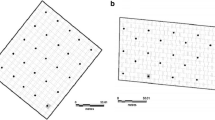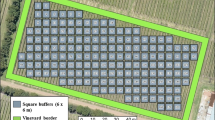Abstract
Vine water status, yield and berry composition are variables within a vineyard. There is current interest in defining zones of similar yield and berry composition. The aim of this study was to compare two methods for identifying zones of similar yield within a 7.5-ha ‘Pinot noir’ vineyard. The two methods were based on: spatial distribution of average midday leaf water potential (ΨL) and plant cell density (PCD = near-infrared/red) which is a vegetation index. A proposal for splitting the vineyard into eight new irrigation zones was assessed. A ‘blind’ zonation based on regular polygons of equal sizes was also established as a standard for comparison. Coefficients of variation (C v) in yield for both methods were compared with that of the blind zonation. In 2006 and 2007, a k-means cluster analysis indicated that variability in ΨL was mainly effected by soil properties. In both years, the vineyard was fully irrigated (100 % ETc). The two methods did not improve yield C v for full irrigation in 2006 and 2007 compared to blind zonation. In 2009, regulated deficit irrigation (RDI) was applied resulting in higher variability in ΨL and yield. The ΨL method of zonation significantly reduced coefficient of variation under RDI but PCD method did not despite the reduction in C v by 16.7 %. We recommend irrigation zonation based on ΨL when RDI is applied.




Similar content being viewed by others
References
Acevedo-Opazo C, Tisseyre B, Guillaume S, Ojeda H (2008) The potential of high spatial resolution information to define within-vineyard zones related to vine water status. Precis Agric 9:285–302
Allen RG, Pereira LS, Raes D, Smith M (1998) Crop evepotranspiration. Guidelines for computing crop water requirements. FAO Irrigation and Drainage paper no 56, p 300
Arnó J (2009) Una investigación sobre la variabilidad intraparcelaria en viña y el uso de sensores láser en viticultura de precisión. PhD, University of Lleida (Spain)
Arnó J, Martínez-Casasnovas JA, Blanco R, Bordes X, Esteve J (2005) Viticultura de precisión en Raïmat (Lleida): experiencias durante el periodo 2002–2004. ACE, Revista de enología, 64
Ayers RS, Wescot DW (1985) Water quality for agriculture. FAO Irrigation and Drainage paper no 29, rev. 1
Basile B, Marsal J, Mata M, Vallverdú X, Bellvert J, Girona J (2011) Phenological sensitivity of Cabernet Sauvignon to water stress: vine physiology and berry composition. Am J Enol Vitic 62(4):452–461
Bramley RGV (2005) Understanding variability in winegrape production systems: 2. Within vineyard variation in quality over several vintages. Aust J Grape Wine Res 11:33–42
Bramley RGV, Hamilton RP (2004) Understanding variability in winegrape production systems: 1. within vineyard variation in yield over several vintages. Aust J Grape Wine Res 10:32–45
Bramley RGV, Lamb DW (2003) Making sense of vineyard variability in Australia. In: Precision viticulture. Proceedings of the IX Congreso Latinoamericano de Viticultura y Enología, Santiago, Chile, pp 35–44
Bramley RGV, Pearse B, Chamberlain P (2003) Being Profitable Precisely—a case study of precision viticulture from Margaret River. In: Australian and New Zealand Grapegrower and Winemaker—annual technical issue, vol 473a, pp 84–87
Burt CM (2004) Rapid field evaluation of drip and microspray distribution uniformity. Irrig Drain Syst 18:275–297
Corwin DL, Lesch SM (2005) Apparent soil electrical conductivity measurement in agriculture. Comput Electron Agric 46:11–43
Cuppitt J, Whelan BM (2001) Determinig potential within-field crop management zones. In: Blackmore S, Grenier G (eds) ECPA 2011—3rd European conference on precision agriculture, vol 1. Agro Montpellier, Ecole Nationale Superieure Agronomique de Montpellier, France, pp 7–12
Dobrowski SZ, Ustin SL, Wolpert JA (2003) Grapevine dormant pruning weight prediction using remotely sensed data. Aust J Grape Wine Res 9:177–182
Friedman SP (2005) Soil properties influencing apparent electrical conductivity: a review. Comput Electron Agric 46:45–70
Fulton A, Schwankl L, Lynn K, Lampinen B, Edstrom J, Prichard T (2010) Using EM and VERIS technology to assess land suitability for orchard and vineyard development. Irrig Sci. doi:10.1007/s00271-010-0253-1
Girona J, Mata M, del Campo J, Arbonés A, Bartra E, Marsal J (2006) The use of midday leaf water potential for scheduling deficit irrigation in vineyards. Irrig Sci 24:115–127
Intrigliolo D, Castel JR (2009) Response of grapevine cv. ‘Tempranillo’ to timing and amount of irrigation: water relations, vine growth, yield and berry and wine composition. Irrig Sci. doi:10.1007/s00271-009-0164-1
Johnson LF, Bosch DF, Williams DC, Lobitz BM (2001) Remote sensing of vineyard management zones implications for wine quality. Appl Eng Agric 17(4):557–560
Johnson CK, Mortensen DA, Wienhold BJ, Shanahan JF, Doran JW (2003) Site-specific management zones based upon soil electrical conductivity in a semiarid cropping system. Agron J 95:303–315
Koundouras S, Tisialtas IT, Zioziou E, Nikolaou N (2008) Rootstock effects on the adaptive strategies of grapevine (Vitis vinifera L. cv. Cabernet Sauvignon) under contrasting water status: leaf physiological and structural responses. Agric Ecosyst Environ 128:86–96
Kriston-Vizi J, Umeda M, Miyamoto K (2008) Assessment of the water stress status of mandarin and peach canopies using visible multispectral imagery. Bio Syst Eng 100:338–345
Lamb D, Hall A, Louis J (2001) Airborne remote sensing of vines for canopy variability and productivity. Aust Grapegrow Winemak 449:89–92
Lampinen BD, Shackel KA, Southwick SM, Olson B, Yeager JT, Goldhamer D (1995) Sensitivity of yield and fruit-quality of French prune to water-deprivation at different fruit-growth stages. J Am Soc Hortic Sci 120(2):139–147
Martinez-Casasnovas JA, Vallés D, Ramos MC (2009) Irrigation management zones for precision viticulture according to intra-field variability. In: EFITA conferences, pp 523–529
Morlat R, Bodin F (2006) Characterization of viticultural terroirs using a simple field model based on soil depth—II. Validation of the grape yield and berry quality in the Anjou vineyard (France). Plant Soil 281:55–69
Ortega R, Esser A, Santibañes O (2003) Spatial variability of wine grape yield and quality in Chilean vineyards: economic and environmental impacts. In: Proceedings of the 4th European conference on precision agriculture, Berlin, Germany, pp 499–506
Proffitt T, Malcolm A (2005) Zonal vineyard management through airborne remote sensing. Aust NZ Grapegrow Winemark 502:22–27
Richards LA (1965) Physical conditions of water in soil. Methods of soil analysis. Agronomy no 9. American Society of Agronomy, Madison, pp 128–152
Rossouw GC (2010) The effect of within-vineyard variability in vigour and water status on carbon discrimination in Vitis vinifera L. cv Merlot. Thesis at Stellenbosch University, department of viticulture and oenology, Faculty of AgriSciences
SAS (2002) Enterprise guide version 4.2. SAS Institute Inc. Cary
Schmidt U, Hanspeter T, kaupenjohann M (2000) Using boundary line approach to analyze N2O flux data from agricultural soils. Nutr Cycl Agroecosyst 57:119–129
Taylor J, Tisseyre B, Bramley R, Reid A (2005) A comparison of the spatial variability of vineyard yield in European and Australian production systems. In: Proceedings of the 5th European conference on precision agriculture, pp 907–915
Turner NC, Long MJ (1980) Errors arising from rapid water loss in the measurement of leaf water potential by pressure chamber technique. Aust J Plant Physiol 7:527–537
USDA-SCS (1975) Soil taxonomy: a basic system of soil classification for making and interpreting soil surveys. U.S. Department of Agriculture Handbook, vol 436. U.S. Govt. Print. Off. Washington, DC
Van Leeuwen C, Fraint P, Choné X, Tregoat O, Koundouras S, Dubourdieu D (2004) Influence of climate, soil, and cultivar on terroir. Am J Enol Vitic 55:207–217
Williams LE, Phene CJ, Grimes DW, Trout TJ (2003) Water use of mature Thompson seedless grapevines in California. Irrig Sci 22:11–18
Acknowledgments
This research was partly supported by funds from Spanish Ministry of Education and Science (PETRI project 95-0825.OP and Rideco-Consolider CDC 2006-00067). We also gratefully acknowledge the financial support of SUDOE for the European project Telerieg SOE1/P2/E082 and the opportunity to carry out this study under the research agreement between CODORNIU and IRTA. The authors would like to thank Jesús del Campo, Carles Paris, Xavier Vallverdú, Germán Estudillos, Núria Bonastre, Núria Civit, Gerard Piñol, Joan Ventura, Amadeu Arbonés, Xavier Casals for their important technical support in the field and specially to Alex Mata who initiated part of these studies. The authors would like also to thank Raïmat Wineries and particularly X. Farré and J. Esteve for allowing to carry out this research in their vineyards and for their keen interest in the results. We are also grateful to Prof. Hossein Behboudian, from Massey University in New Zealand, for his critical review of an early version of this manuscript.
Author information
Authors and Affiliations
Corresponding author
Additional information
Communicated by V. Sadras.
Rights and permissions
About this article
Cite this article
Bellvert, J., Marsal, J., Mata, M. et al. Identifying irrigation zones across a 7.5-ha ‘Pinot noir’ vineyard based on the variability of vine water status and multispectral images. Irrig Sci 30, 499–509 (2012). https://doi.org/10.1007/s00271-012-0380-y
Received:
Accepted:
Published:
Issue Date:
DOI: https://doi.org/10.1007/s00271-012-0380-y




